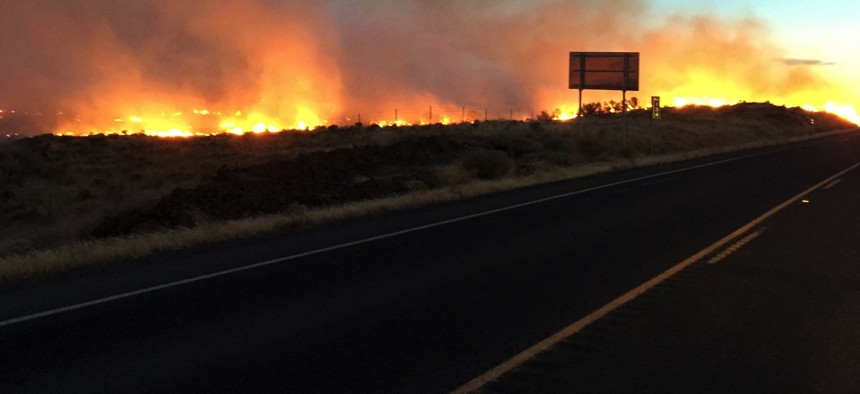The Charbroiled Northwest; Busy Special Sessions in Sacramento

A fire burns land along State Route 14 near Roosevelt, Wash., on Aug. 4, 2015. Mark Winn / Washington State Department of Transportation

Connecting state and local government leaders
Also, Atlanta planners push “active transportation” and a hard-pressed Colorado city has big dreams of building the Silicon Valley of marijuana.
PORTLAND, Oregon: Communities battling blazing wildfires in the Northwest may get a break this week, reports The Oregonian. Winds are calming and cooler temperatures are descending on the area. But weekend fires have destroyed some 80 homes in Oregon’s Grant County near John Day and in Washington state near Lake Chelan, there are six separate fires raging. Locals are rallying to support neighbors who have lost their homes. They’re using the Internet and the U.S. Postal Service to provide cash. The Red Cross is setting up shelters and serving meals.
These are dispatches from the horrible, charbroiled new normal, as Subhankar Banerjee explained last month at The Nation in a report on the Paradise Fire smoldering deep inside Washington’s Olympic National Park. That fire is burning through a primeval rainforest, one of the nation’s wettest stretches of land, where in the vast course of geologic history, fires have usually come only once every thousand years. “When fire can eat a rainforest in a relatively cool climate,” he wrote, “you know the Earth is beginning to burn.” [The Oregonian, The Nation]
SACRAMENTO, California: Lawmakers in the Golden State returned to work Monday to participate in special sessions centered on healthcare and transportation. Dealmaking and compromise must win the day if Democrats are going to secure support from Republicans to finance any new programs. An ambitious climate bill is also on the table. It would slash fossil fuel use on roads and bring use of renewables for electricity up to 50 percent across the state. Gov. Jerry Brown and leaders in both legislative chambers support the proposal; Republican minority members not so much. Utility companies are lobbying hard to shape the final proposal. “We are negotiating around the clock,” Senate President Pro Tem Kevin de León, a Los Angeles Democrat, told The Sacramento Bee.
Also: There’s an historic, long-overdue marjuana proposal on the table. As the paper puts it:
The prospect of voters legalizing recreational marijuana in 2016 has helped propel the most promising push yet to regulate medical cannabis.
For the record, medical marijuana was effectively legalized in California by ballot initiative in 1996. [The Sacramento Bee]
ATLANTA, Georgia: The city is drawing up a new transportation plan that will promote walking and biking, or what the city’s transportation planner Byron Rushing calls “active transportation.” He told public radio station WABE that planners are “really hearing from people on the street that they are gung-ho about getting out of their cars.” The plan dovetails with the city’s BeltLine revitalization effort—the trail and park system being built up along a railway corridor around the core of the city that has drawn more people and employers in from the suburbs. “This is not just a bureaucratic process, with policymakers staring at maps,” writes WABE paraphrasing Rushing in an openly pro-plan piece. “They’re looking at how people really travel now.” [WABE; CityLab]
PUEBLO, Colorado: This working-class city in the dry fields of southern Colorado has been struggling ever since the U.S. steel industry collapsed in the 1980s and what was left of the one-time booming Colorado Fuel and Iron mills shuttered. Now residents hope they’ve found something special that could take the place of long-dead King Steel. They want to turn Pueblo into “the Silicon Valley of marijuana,” reports High Country News. The story opens with resident Mark Morley looking out over 30 acres he owns just east of town.
If he planted corn on this land, each acre would require approximately 2.2 acre-feet of water per year and produce $768 in annual sales… That same acre planted with marijuana would require roughly 2.65 acre-feet of water — and gross Morley $6 million… Welcome to the big business of rural weed.
BANGOR, Maine: The Daily News looks at recently compiled beer-tweeting data. It reports that Mainers are divided between areas that tweet a lot about pale ales and areas that tweet a lot about Bud Light. On a map produced by the University of Kentucky, the coastal areas of Maine where pale ales tweets predominate appear in blue and the central and western areas where Bud Light tweets predominate appear in red. How do you think that correlates with state politics? Other “takeaways” from the beer map include the fact that Bangor likes porters, Portland likes hoppy brews, and Maine brands like Shipyard and Geary’s and Bissell Brothers apparently don’t spur enough tweets to even register. [Bangor Daily News]
John Tomasic is a journalist based in Boulder, Colorado.

NEXT STORY: NG 911 prepper: County updates emergency phone system




